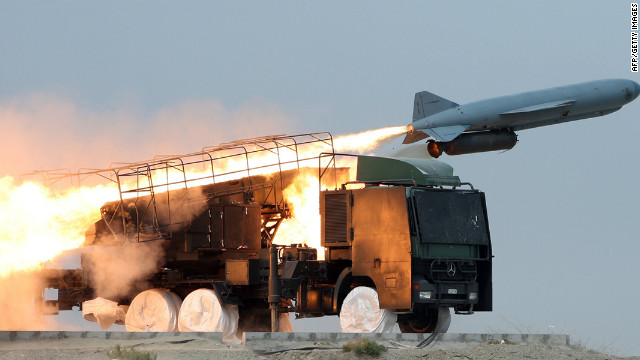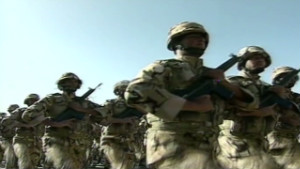Feed: CNN.com - WORLD
Posted on: Wednesday, December 28, 2011 2:14 PM
Author: CNN.com - WORLD
Subject: Analysis: Saber-rattling in Strait of Hormuz
It is just 34 miles (55 kilometers) wide and dotted with islands and rocky outcrops, a channel that links the Persian Gulf with the Indian Ocean. Like many marine "chokepoints," the Strait of Hormuz has long commanded the attention of empires and their navies. |
Analysis: Saber-rattling in Strait of Hormuz

- One-third of oil carried by sea passes through Hormuz Strait
- Iran's VP warns that his country may block the Strait
- Iran is holding a 10-day military exercise in the area
- Western diplomats describe the maneuvers as volatile behavior
(CNN) -- It is just 34 miles (55 kilometers) wide and dotted with islands and rocky outcrops, a channel that links the Persian Gulf with the Indian Ocean. Like many marine "chokepoints," the Strait of Hormuz has long commanded the attention of empires and their navies.
And in recent decades it has become even more critical: one-third of the oil carried by sea passes through Hormuz -- that's some 15 million barrels every day, according to the U.S. Energy Information Administration.
Now Iran's Vice-President is warning that the Islamic Republic could block the Strait if sanctions are imposed on its exports of crude. France, Britain and Germany have proposed such sanctions as punishment for Iran's lack of co-operation on its nuclear program.
To demonstrate its intent, Iran is holding a 10-day military exercise in an area from the eastern part of the Strait out into the Arabian Sea, with some elements playing the part of enemy forces. Western diplomats describe the maneuvers as further evidence of Iran's volatile behavior, following the occupation of the British embassy in Tehran. And it's not the first time Iran has used this vital sea lane in a high-stakes game of brinkmanship.
The Strait is thought to have been named for the Persian Hur-mogh, the date-palm found on the coast. It was mentioned in a first century mariners' account, The Periplus of the Erythtraean Sea, and down the ages was known for its pearls.
 Iran's military might in Iraq
Iran's military might in Iraq  Iran military posturing
Iran military posturing  Iran-Iraq alliance unlikely, expert says
Iran-Iraq alliance unlikely, expert says But as oil became the lubricant of the world economy, the Strait of Hormuz -- and the sea lanes leading to it -- became a geo-strategic flashpoint. So narrow is the Strait, with sea-lanes just two miles wide heading in and out of the Gulf, ships must pass through Iranian and Omani territorial waters. In addition, Iran and the United Arab Emirates dispute sovereignty over several islands close to the Strait.
Iran last tried to disrupt and sabotage Gulf shipping during its decade-long conflict with Iraq, when the Arab Gulf states were funding Saddam Hussein's war effort. When Iraq began attacking Iranian tankers in 1984, Iran responded by targeting vessels headed to and from Gulf ports. And it began a guerrilla war at sea -- laying mines in shipping lanes.
That led the U.S. to provide military escorts for Kuwaiti shipping. In 1988, an Iranian mine damaged and nearly sank the USS Samuel B. Roberts, prompting U.S. President Ronald Reagan to order retaliatory strikes against Iranian oil platforms and naval vessels. Two platforms -- Sirri and Sassan -- were destroyed and an Iranian warship sunk in Operation Praying Mantis.
Since then, the U.S. has increased co-operation with the navies of Gulf Arab states and established the headquarters of the U.S. Fifth Fleet in Bahrain.
But Iran's neighbors understand that their reliance on the Strait to transport oil and liquefied natural gas remains vulnerable. According to U.S. diplomatic cables, Iraqi Prime Minister Nouri al-Maliki said in December 2009 that "Iraq would be the hardest hit" if tensions led Iran to try to blockade the Strait. Kuwaiti official have suggested building a 1,000-mile land pipeline to the Gulf of Oman to reduce reliance on the maritime route.
Today, after decades of sanctions, Iran does not have the naval power to block the Strait, and its ageing air force would be no match for U.S. and Gulf fighter jets. But military experts say Iran could wage "asymmetrical warfare" -- involving mines and attacks by Revolutionary Guards' patrol boats. It has also developed a class of small submarines, three of which were launched last month, according to the Iranian naval commander quoted by the Fars news agency.
Even bellicose language from Iranian politicians has already caused jitters in oil markets. Earlier this month an Iranian legislator, Parviz Sarvari, warned: "Soon we will hold an exercise on closing the Strait of Hormuz. If the world wants to make the region insecure, we will make the world insecure."
Any attempt to interfere with shipping would be a double-edged sword for Tehran. Iran also relies on the Strait to export its crude and other products, and has to import most of its refined gasoline for lack of refining capacity. The U.S. State Department says there is "an element of bluster" in the Iranian threats.
Even so, analysts worry that the deterioration in U.S.-Iranian relations could magnify the consequences of a collision or provocation in the Gulf. Shortly before retiring as Chairman of the U.S. Joint Chiefs of Staff, Admiral Mike Mullen said: "If something happens, it's virtually assured that we won't get it right, that there will be miscalculations which would be extremely dangerous in that part of the world."
Trita Parsi, President of the National Iranian American Council, told CNN Monday that an incident in the Strait "could spark a wider war precisely because there's no communication, no diplomacy and no de-escalatory mechanisms between the United States and Iran."
Most Popular
Loading weather data ...













